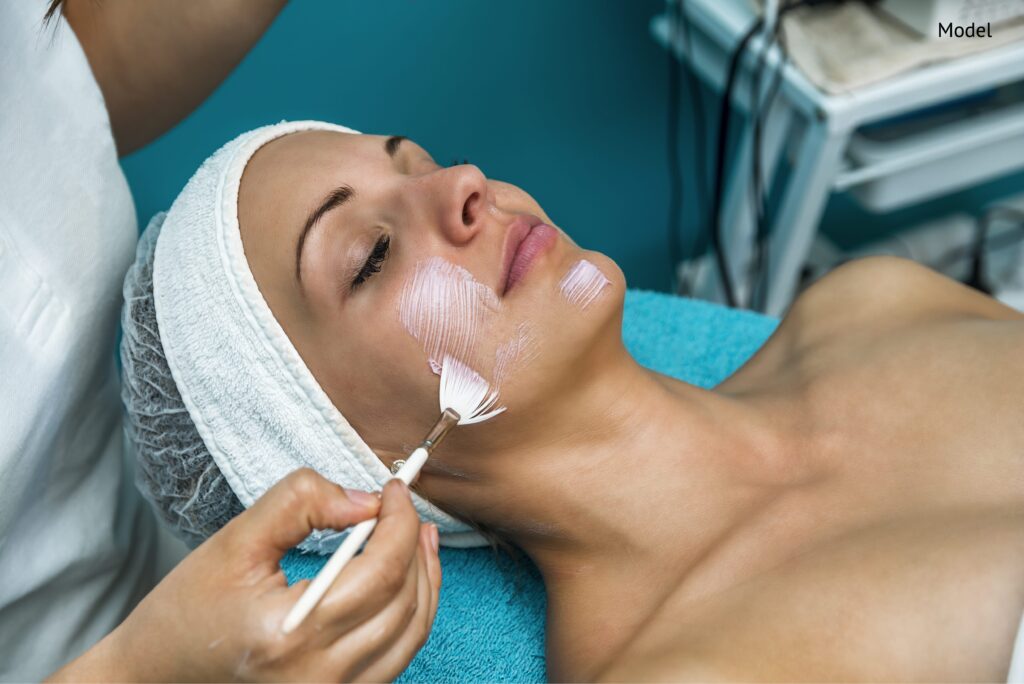Preventing the onset of visible aging is high on many cosmetic wish lists. Chemical peels are a great way to achieve younger, healthier-looking skin without undergoing invasive surgery or expensive laser treatments.
A chemical peel applies a solution to the face, neck, hands, or arms, and allows the solution to penetrate the skin to correct a variety of genetic and age-related concerns such as wrinkles, fine lines, acne, melasma, or hyperpigmentation.
Chemical peels work at various strengths to treat different skin types and concerns, and there is a chemical peel appropriate for every individual and their specific needs. By using the Bridges Accumulative Age Layering Matrix, Dr. Bridges can help pair each patient with the chemical peel that will best suit their cosmetic needs.
How to Understand Your Skin?
While it is simple to see the difference between young and old skin and oily and dry skin, it is much more challenging to understand skin type. The Fitzpatrick system is used to classify skin tones so that patients understand what treatments and ingredients are beneficial or harmful to their skin.
Fitzpatrick Skin Type System
The Fitzpatrick system divides individuals into six groups based on skin, hair, and eye color. This system helps determine skin cancer risk and understand which non-invasive treatments (such as chemical peels) are appropriate.
Fitzpatrick Type I: Pale white skin, blue or green eyes, and blond or red hair with skin that never tans but always burns.
Fitzpatrick Type II: Fair skin and blue eyes that will occasionally tan but more often burn.
Fitzpatrick Type III: Darker white skin that will initially burn but then tan.
Fitzpatrick Type IV: Light brown skin that tans easily with or without a burn.
Fitzpatrick Type V: Brown skin that tans easily.
Fitzpatrick Type VI: Dark brown or black skin that tans easily and darkly.
What Peels Are Available?
Glycolic Acid Peel
The glycolic acid peel uses a gentle alpha hydroxy acid exfoliant that is water-soluble and all natural. This acid peel is one of the mildest forms of chemical peels and is appropriate for all skin types.
Glycolic acid penetrates the skin to increase collagen and elastin production, allowing it to minimize the appearance of fine lines, wrinkles, sun-damaged cells, and enlarged pores. This peel provides healthier-looking skin with minimal downtime or side effects.
Salicylic Acid Peel
The salicylic acid peel uses beta hydroxy acid to provide deep skin exfoliation. This peel is ideal for patients suffering from acne and acne scars because of its strong anti-inflammatory properties.
In addition to acne, salicylic acid peels can treat fine lines, wrinkles, and the appearance of dull skin. This peel is also appropriate for darker skin tones; however, precautions should be taken to prevent post-peel hyperpigmentation.
Jessner’s Peel
This combination peel uses salicylic acid, lactic acid, and resorcinol to treat acne, psoriasis, and eczema. The Jessner peel penetrates multiple layers of the skin to stimulate collagen and elastin production while evening out skin tone.
This peel is appropriate for all skin tones and all ages and is ideal for those looking for relief from skin blemishes and age-related skin concerns.
Vi Peel™
The Vi Peel™ can improve tone, texture, and clarity for all skin types. This comfortable peel can reduce the appearance of sun damage, freckles, hyperpigmentation, and acne.
This is one of the safest peels for darker skin types (Fitzpatrick IV-VI) and comes with little downtime or risk for any patient. This peel uses a combination of salicylic acid, Retin-A, Vitamin C, phenol, and trichloroacetic acid to treat a variety of concerns.
Trichloroacetic Acid
The TCA peel provides dramatic results. This peel is not appropriate for those who fall under the Fitzpatrick IV-VI categories, as it can potentially lead to hyperpigmentation. For those who are candidates, the TCA peel provides brighter, firmer, and softer skin.
This peel stimulates collagen and elastin production and reduces the appearance of wrinkles, sun spots, melasma, acne scars, and freckles. The TCA peel is available in many strengths depending on your skin concern.
Phenol Peel
The phenol peel provides the most dramatic results. Several variations exist, but the most popular is the Hetter Peel. The Hetter Peel is designed to decrease the risk of skin pigment loss while retaining the benefit of wrinkle reduction. This peel is not appropriate for those who fall under the Fitzpatrick IV-VI categories. For those who are candidates, the phenol peel provides brighter, tighter skin and very good wrinkle improvement.
This peel stimulates collagen production and remodeling of the dermis as well as improvement in melasma, acne scars and freckles.
What Should You Know Before and After Your Peel?
Chemical peels affect multiple layers of the skin and require up to one week of downtime. Before you undergo a chemical peel, you should prepare your skin by stopping prescription drugs like Accutane, avoiding sun exposure, applying prescribed lotions such as Retin-A, and limiting skin stress.
Your recovery period will depend on the strength of your peel. Typically, you can expect your skin to flake off for several days. Although it may be difficult, you must leave your skin alone during this process. Do not pull or pick at the flaking skin; instead, let it come off naturally. You can expect redness, tenderness, tightness, and soreness that will dissipate with time.
Your skin will be sensitive to the sun after your chemical peel. Protect your skin with a broad-spectrum sunscreen and limit your time in the sun when possible. Excessive exposure can result in uneven skin tone. Keeping the skin moisturized and hydrated will help extend your chemical peel results.
For more information on the chemical peels offered at Bridges to Beauty, contact Dr. Bridges by calling (318) 219-8555 or by filling out our online contact form.


